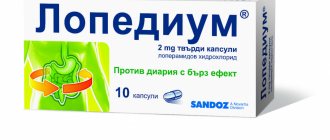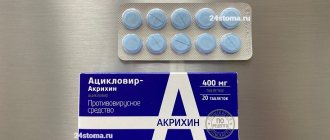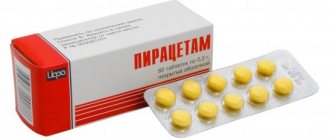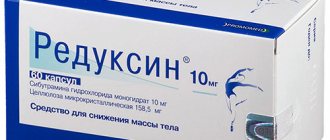Pharmacological properties of the drug Olfen™
Contains diclofenac sodium salt, an NSAID with pronounced anti-inflammatory, analgesic and antipyretic effects. The mechanism of action of the drug is associated with inhibition of prostaglandin biosynthesis, which plays an important role in the development of inflammation, pain and fever. Thanks to its anti-inflammatory and analgesic effect, it reduces the severity of pain in the joints at rest and during movement, reduces morning stiffness and swelling of the joints, and increases functional ability. In case of post-traumatic or postoperative inflammation, it helps to quickly reduce the severity of pain, reduces inflammation and swelling of the wound. In addition, the pronounced analgesic effect of the drug was demonstrated in clinical trials for moderate and severe non-rheumatic pain syndrome. Reduces the severity of pain during primary dysmenorrhea. The drug Olfen-100 SR Depocaps is indicated for all patients who require a daily dose of at least 100 mg to reduce symptoms. The prolonged release of the active ingredient from the drug provides a long-lasting supportive effect. It is convenient to use the drug - once a day. When used in combination to relieve postoperative pain, the drug significantly reduces the need for opiates. After taking 100 mg of the drug, the average maximum concentration in the blood plasma is 0.43 mcg/ml (1.35 μmol/l) is achieved on average after 3.5 hours. The average volume of distribution is 0.12–0.17 l/kg, binding to blood plasma proteins - 99%. Therapeutic concentration in blood plasma is 0.7–2 mcg/ml. Repeated administration of the drug does not change the kinetic parameters. If the recommended intervals between doses of the drug are observed, accumulation does not occur. Diclofenac penetrates into the synovial fluid, where its maximum concentration is observed 2–4 hours after reaching its maximum value in the blood plasma. The half-life from synovial fluid is 3-6 hours, as a result, 4-6 hours after taking the drug, the concentration of diclofenac in synovial fluid is significantly higher than in blood plasma, and remains high for up to 12 hours. Approximately half of the amount of the active ingredient is metabolized by the primary passing through the liver. As a consequence, the AUC determined after oral or rectal administration is approximately half of the AUC determined after parenteral administration of the same dose. After oral administration, only 60% of diclofenac enters the systemic circulation unchanged. Biotransformation occurs partly by glucuronidation of the unchanged molecule, but mainly by hydroxylation and methoxylation to form 2 pharmacologically active phenolic metabolites that are less active than diclofenac. Diclofenac is eliminated from blood plasma with a systemic clearance of 263 ± 56 ml/min (mean ± SD). The half-life is 1–2 hours. About 60% of the dose taken is excreted by the kidneys in the form of metabolites and less than 1% unchanged, the rest is excreted in the bile in a metabolized form. The pharmacokinetics of the drug does not change depending on age. In patients with impaired renal function, when using an individually selected dose, no increase in the level of unchanged active substance was observed. With creatinine clearance ≤10 ml/min, the level of metabolites in the blood plasma is approximately 4 times higher than in healthy individuals. In patients with impaired liver function (chronic hepatitis, compensated cirrhosis), the pharmacokinetics do not change. At the same time, metabolites were also excreted in bile. From Olfen-100 SR Depocaps capsules, diclofenac is completely absorbed. Due to the delayed release of the active ingredient, the maximum plasma concentration is lower than with other dosage forms, but persists for a longer period. When taken during or after a meal, absorption occurs more slowly than when taken on an empty stomach, but the extent of absorption does not change. Olfen-50 Lactab is coated with an enteric protective coating, so absorption of diclofenac occurs after passing through the stomach. The maximum concentration in blood plasma (0.92 mg/l) is achieved 2.6 hours after administration of a dose of 50 mg on an empty stomach. The relationship between plasma concentration and dose is linear. If Olfen-50 Lactab is taken during or after a meal, its passage through the stomach is slower than when taken on an empty stomach and can take 2.5–12 hours. However, this does not affect the degree of absorption of the active ingredient. After insertion into the rectum, the gelatin coating of the Olfen-100 Rectocaps capsule disintegrates within a few minutes. The active substance is absorbed within 30 minutes, enters the systemic circulation and is distributed in organs and tissues. Olfen-100 Rectocaps capsules do not irritate the rectal mucosa. Olfen-75 injection solution is used for initial treatment of inflammatory-degenerative rheumatic diseases, as well as to reduce the severity of pain caused by non-rheumatic inflammation, with the effect developing within 15–30 minutes.
Pharmacodynamics and pharmacokinetics
The active component of Olfen-75, diclofenac sodium, belongs to non-steroidal drugs with pronounced antirheumatic , analgesic , anti-inflammatory and antipyretic properties. Its action is based on preventing the biosynthesis of prostaglandins , which affect inflammatory processes, fever and pain.
For rheumatic diseases, the drug helps get rid of the signs and symptoms of the disease, it relieves pain, normalizes the functioning of joints and eliminates stiffness. In case of inflammation after injuries and operations, Olfen-75 promotes the rapid disappearance of pain, relieves the severity of swelling due to wounds and inflammation. In addition, it greatly reduces the need for opioid . This drug also acts as an analgesic for diseases of non-rheumatic origin. It reduces pain 15-30 minutes after internal administration.
This remedy is well suited for starting the treatment of many inflammatory diseases.
The degree of its binding to plasma proteins is almost 100%. It penetrates into the synovial fluid . The maximum concentration of the drug is achieved 2-4 hours after the peak concentration. The half-life of synovial fluid is approximately 4-5 hours. High concentrations of diclofenac sodium in synovial fluid are observed even after 12 hours.
The drug is metabolized in part by glucuronidation and methoxylation to form active phenolic metabolites .
The half-life of the drug is approximately 1.5 hours. About 60% is excreted through the kidneys in the form of metabolites and less than 1% unchanged. The remaining amount is excreted in metabolized form with bile and feces.
Indications for use of the drug Olfen™
Extended-release capsules, film-coated tablets : for inflammatory and degenerative rheumatic diseases of the joints, periarticular tissues, muscles, tendons and spine, namely arthritis, arthrosis, polyarthritis, spondyloarthritis, ankylosing spondylitis, soft tissue rheumatism, bursitis, tendovaginitis, tendinitis, lumbago, sciatica, cervical syndrome; acute attack of gouty arthritis; pain, inflammation and swelling after injury and surgery; pain and/or inflammation in gynecology (primary dysmenorrhea, adnexitis); as an adjuvant for acute infections of the throat, nose or ear, accompanied by pain: acute tonsillitis, pharyngitis, otitis media. Fever is not an indication for prescribing this drug. In addition, Olfen-100 Rektocaps has a positive effect on migraines. Injection solution: parenterally in the form of intramuscular injection, the drug is used for the initial treatment of rheumatism, rheumatoid arthritis, ankylosing spondylitis, arthrosis, spondyloarthritis, vertebral pain syndrome, extra-articular forms of rheumatism, acute gouty arthritis, renal and hepatic colic, pain, inflammation and swelling after injuries and surgical interventions.
Use of Olfen™
The initial daily dose for adults is usually 100–150 mg. In less severe cases and with long-term therapy, in most cases it is sufficient to use the drug at a dose of 50–100 mg/day. The daily dose is usually divided into 2-3 doses. For long-term treatment, take, for example, 1 tablet Olfen-50 Lactab 2 times a day or 1 capsule Olfen-100 SR Depocaps 1 time a day. Take before meals, without chewing and with a glass of water. To prevent night pain and morning stiffness, taking Olfen-50 Lactab throughout the day can be combined with taking Olfen-100 Rectocaps (100 mg) before bed (up to a maximum daily dose of 150 mg). For primary dysmenorrhea, the daily dose is selected individually and is usually 50–150 mg; The initial dose can be 50–100 mg and, if necessary, can be increased over several menstrual cycles to a maximum of 200 mg/day. Olfen-100 Rectocaps capsules are administered rectally. If necessary, before administration, the capsules can be moistened with water and administered with a blunt end. After administration of the drug, the patient should be in a horizontal position for at least 20–30 minutes. The initial daily dose is usually 100–150 mg. In milder cases and with long-term therapy, a dose of 100 mg/day is sufficient. To prevent night pain and morning stiffness, administration of Olfen-100 Rectocaps before bedtime can be combined with taking Olfen-50 Lactab during the day (up to a maximum daily dose of 150 mg). Due to the high content of the active substance, Olfen-50 Lactab, Olfen-100 SR Depocaps and Olfen-100 Rectocaps are not recommended for children. The duration of use depends on the indications and results of treatment. The solution is injected deep IM into the upper outer quadrant of the gluteal muscle once a day. In severe cases (for example, colic), it is possible to prescribe the drug 2 times a day with an interval of several hours (the injection site should be changed). A combination of parenteral administration with other forms of Olfen (Lactab, Depocaps, Rectocaps) is possible until the total maximum daily dose of 150 mg is reached. The duration of parenteral use of the drug should not exceed 2 days. If necessary, you can continue therapy with other dosage forms of Olfen. Children . The drug Olfen-100 SR and Olfen-100 Rectocaps are not recommended for use in children due to the high content of the active substance - diclofenac sodium. Olfen-75 injection solution is also not used for treatment in children.
Instructions for use Olfen (Method and dosage)
The dosage in which Olfen-75 ampoules are used is selected for each patient individually . The minimum dose is taken for the shortest possible period of time.
The instructions for Olfen also recommend that you first conduct a skin test for hypersensitivity to the components of the drug. In the absence of negative reactions, the drug continues to be used in the form of intramuscular infusions .
As a rule, the dosage is administered in a single dose of 75 mg Olfen in ampoules, applied once a day. Injections are given into the upper outer quadrant of the gluteal muscle. Immediately after the ampoule is opened, the solution should be used. If there is any unused solution left in an open ampoule, it must be discarded.
For severe pain, if Olfen injections are used, the instructions for use recommend injections 2 times a day with a break of several hours between them. The location of the infusion should be different. Combination with other dosage forms of Olfen is acceptable, but the maximum daily dosage should not exceed 150 mg.
The duration of parenteral use of the drug should not exceed 2 days. If it is necessary to continue therapy, Olfen-75 is replaced by other forms of the drug. In addition, this drug cannot be used for intravenous administration.
Contraindications to the use of Olfen™
- hypersensitivity to diclofenac or other components of the drug;
- peptic ulcer of the stomach and duodenum;
- urticaria, rhinitis due to the use of acetylsalicylic acid or other NSAIDs;
- history of attacks of “aspirin” asthma;
- III trimester of pregnancy;
- Crohn's disease or ulcerative colitis;
- severe heart failure;
- severe liver failure;
- severe renal failure (creatinine clearance 30 ml/min);
- patients with a high risk of postoperative bleeding or incomplete homeostasis, hematopoietic disorders or cerebrovascular bleeding.
Olfen-100 SR and Olfen-100 Rectocaps should not be used in combination with high doses of anticoagulants or other anti-inflammatory drugs.
Side effects of Olfen™
Frequency: very often (1/10), often (1/100, 1/10), infrequently (1/1000, 1/100), rarely (1/10,000, 1/1000), very rarely (1/10 000). From the gastrointestinal tract: infrequently - pain in the epigastric region, nausea, vomiting, diarrhea, intestinal spasms, dyspepsia, flatulence, loss of appetite; rarely - gastrointestinal bleeding (bloody vomiting, melena, bloody diarrhea), ulcerogenic effect with or without bleeding or perforation; very rarely - nonspecific hemorrhagic colitis and exacerbations of nonspecific ulcerative colitis or Crohn's disease, aphthous stomatitis, glossitis, esophageal lesions, intestinal strictures, constipation, pancreatitis. From the central nervous system and sensory organs: infrequently - headache, dizziness, cerebrovascular accident; rarely - increased fatigue; very rarely - paresthesia, memory impairment, disorientation, insomnia, irritability, convulsions, depression, anxiety, nightmares, tremor, psychotic reactions, aseptic meningitis, blurred vision, diplopia, hearing impairment, tinnitus, taste disturbances. From the skin: infrequently - skin rashes; rarely - urticaria, very rarely - bullous rashes, eczema, erythema multiforme, Stevens-Johnson syndrome, Lyell's syndrome (toxic epidermal necrolysis), erythroderma (exfoliative dermatitis), hair loss, photosensitivity, purpura, including allergic purpura. From the kidneys: rarely - edema, very rarely - acute renal failure, hematuria, proteinuria, interstitial nephritis, nephrotic syndrome, necrotizing papillitis. From the liver: often - increased aminotransferase activity in the blood serum (sometimes moderately or significantly expressed), rarely - hepatitis with or without jaundice, very rarely - fulminant hepatitis. From the blood system: very rarely - thrombocytopenia, leukopenia, agranulocytosis, hemolytic and aplastic anemia. Hypersensitivity reactions: rarely - anaphylactic and anaphylactoid systemic reactions, including hypotension, very rarely - vasculitis, pneumonia. From the cardiovascular system: very rarely - tachycardia, chest pain, hypertension (arterial hypertension), heart failure.
Special instructions for the use of Olfen™
In patients with a history of peptic ulcers, ulcerative colitis, Crohn's disease or liver dysfunction, regular monitoring is required during the period of use of the drug. In elderly patients, gastrointestinal bleeding or ulcerogenic effects with perforation are observed more often and have more severe consequences. They can occur during any period of treatment, and in some cases asymptomatically. If gastrointestinal bleeding or other indications of an ulcerative process occur during treatment with Olfen, the drug should be discontinued. Treatment with Olfen should be discontinued if clinical symptoms of liver disease or other side effects (eg eosinophilia, skin rash, etc.) occur. After cessation of treatment, increased enzyme activity gradually returns to normal. As with the treatment of other NSAIDs, liver function should be regularly monitored during long-term therapy with Olfen. In addition to increased liver enzyme activity, isolated cases of severe liver damage, including jaundice and fatal fulminant hepatitis, have been reported. Patients with porphyria should prescribe Olfen with caution, as the drug may cause worsening of the condition. Because prostaglandins play an important role in maintaining renal blood flow, special attention should be paid to patients with impaired renal function, heart failure, the elderly, patients taking diuretics, and patients with dehydration. Monitoring of renal function is recommended. Caution should be exercised when prescribing the drug to elderly patients. In particular, the use of lower doses, monitoring of renal and liver function, as well as the composition of peripheral blood, is recommended. Olfen may temporarily inhibit platelet aggregation, so patients with coagulation disorders should be under medical supervision. Patients in whom the use of the drug causes dizziness or other side effects from the central nervous system should avoid driving vehicles and working with potentially dangerous mechanisms. The period of pregnancy and lactation I and II trimesters. There are no clinical data regarding women taking Olfen-100 SR Depocaps during pregnancy. Animal studies have shown no effects during pregnancy, on embryo/fetal development, during childbirth or in postnatal development. During pregnancy, the drug should be used only for absolute indications and in minimally effective doses. III trimester. Olfen-100 SR Depocaps should not be prescribed in the third trimester of pregnancy, since the use of COX inhibitors can cause premature closure of the ductus arteriosus in the fetus and impaired myometrial tone during labor and the absence of uterine contractions. After oral administration of 50 mg of the drug at a 5-hour interval, a small amount of the active substance was observed in mother's milk, so no side effects are expected in the newborn.
Olfen transdermal patch, 140 mg N5 (5 pieces) - Instructions
Dosage form
Transdermal patch, 5 pieces per pack.
Compound
Active ingredient: diclofenac sodium;
1 patch contains diclofenac sodium 140 mg / 12:00 per 140 cm 2;
Excipients: macrogol lauryl ether, diisopropyl adipate, glycerin (E 422), propylene glycol, sorbitol solution crystallizes (E 420), sodium polyacrylate, sodium carmellose (E 466), butyl methacrylate copolymer basic, colloidal silicon dioxide, light natural kaolin, sodium anhydrous sulfite (E 221), Trilon B, dibutylated hydroxytoluene (E 321), dry aluminum-potassium sulfate, acid must (E 334), L-menthol, purified water
Base: non-woven fabric (EL-8100S), polypropylene film.
Pharmacological group
Non-steroidal anti-inflammatory drugs for topical use.
Pharmacological properties
Pharmacodynamics.
Olfen transdermal patch is a non-steroidal anti-inflammatory drug (NSAID) with analgesic properties, intended for topical use. The therapeutic effect is due to the inhibitory effect of diclofenac sodium on the synthesis of prostaglandins.
When the drug Olfen is applied topically, the transdermal patch penetrates the skin, reaching the subcutaneous tissues, and has an analgesic, anti-inflammatory effect, and reduces tissue swelling. When administered to patients with significant sports injuries, the Olfen transdermal patch demonstrated effective pain-relieving effects compared with placebo.
Pharmacokinetics.
The concentration of diclofenac in tissues is maintained due to constant penetration from the patch and does not depend on the time of day. The average concentration of the substance in blood plasma is approximately 3 ng/ml.
The mechanism of metabolism and excretion of diclofenac after topical application corresponds to that with oral administration of diclofenac sodium preparations. The half-life is 1-2 hours.
Indications for use
Local short-term treatment:
- inflammation of tendons, ligaments, muscles and joints of traumatic etiology, for example, with sprained ligaments and tendons, dislocations, bruises;
- localized forms of rheumatism of soft tissues and joints.
Directions for use and doses
The patch is applied to the affected area of the body. Apply 1 patch 2 times a day, morning and evening. Before use, remove the transparent film that protects the surface of the patch. The patch cannot be divided. Do not use the patch with an occlusive dressing.
If necessary, the patch is fixed with an elastic bandage. One transdermal patch is designed for continuous use for 12:00.
Only 1 patch can be applied to one damaged area at a time. The maximum daily dose is 2 patches, even if there is a need to apply the patch to more than one area.
The patch should be used for the shortest possible period.
The duration of treatment should not exceed 7 days.
Contraindications
Hypersensitivity to diclofenac, acetylsalicylic acid, other non-steroidal anti-inflammatory drugs, analgesics or to any component of the drug. A history of attacks of bronchial asthma, urticaria or acute rhinitis caused by taking acetylsalicylic acid or other non-steroidal anti-inflammatory drugs. Exacerbation of gastric and duodenal ulcers, open skin lesions, burns, skin infections or eczema.
Interaction with other drugs and other types of interactions
Systemic absorption of diclofenac when used correctly with Olfen transdermal patch is very low compared to oral administration, so interaction with other drugs is unlikely.
Features of application
Olfen transdermal patch should not be applied to open wounds (eg scrapes, cuts) or eczematous areas of the skin. Avoid contact with eyes and mucous membranes.
If after 3 days of treatment the patient's condition has not improved or worsened, you should consult a doctor.
To reduce the risk of side effects, treatment should use the minimum effective dose of diclofenac sodium for the shortest possible period of time.
In patients with allergies or bronchial asthma, bronchospasm may occur when using NSAIDs in history.
If any skin rash occurs after using Olfen transdermal patch, treatment should be discontinued.
Avoid exposure to direct sunlight or solarium radiation at the site of application for approximately 1 day to reduce the risk of photosensitivity.
Although the risk of systemic adverse reactions is minimal, Olfen transdermal patch should be used with caution in patients with impaired renal, cardiac or hepatic function, a history of gastric or duodenal ulcers, intestinal phlegmon or bleeding diathesis.
Elderly patients should use NSAIDs with caution due to the greater likelihood of side effects.
Olfen transdermal patch contains propylene glycol and dibutylated hydroxytoluene. Propylene glycol may cause skin irritation. Dibutylated hydroxytoluene may cause local skin reactions (eg contact dermatitis) or irritation of the eyes and mucous membranes.
It is not recommended to use any other NSAIDs or medicines containing diclofenac when using Olfen transdermal patch.
Use during pregnancy or breastfeeding
I and II trimesters
There are no sufficient clinical data on the cutaneous use of diclofenac during pregnancy. Animal studies have shown reproductive toxicity following systemic use of the drug.
Inhibition of prostaglandin synthesis can negatively affect pregnancy and/or embryofetal development of the fetus. Data from epidemiological studies indicate an increased risk of miscarriage, heart defects and gastroschisis after the use of prostaglandin synthesis inhibitors in early pregnancy. This risk is believed to increase with increasing drug dose and duration of therapy.
In the first and second trimesters of pregnancy, the dose should be minimal and the duration of treatment should be as short as possible.
III trimester
Diclofenac sodium is contraindicated in the third trimester of pregnancy due to the fact that all prostaglandin synthesis inhibitors can:
- cause in the fetus:
- cardiopulmonary toxicity (with premature closure of the ductus arteriosus and development of pulmonary hypertension)
- impaired renal function, progressing to renal failure with oligohydramnios;
- induce in mother and child:
- prolonged bleeding - an effect associated with inhibition of platelet aggregation, which can occur even when taking very low doses of the drug
- inhibition of contractions of the uterine muscles, which leads to a delay or prolongation of labor.
Lactation
A small amount of diclofenac and its metabolites pass into breast milk. The decision to use the drug during breastfeeding is made by the doctor if there are compelling reasons for its use, when the expected benefit of treatment outweighs the potential risk. Olfen™ transdermal patch should not be applied to the breasts or large areas of skin and should not be used for long periods of time.
The ability to influence the reaction rate when driving vehicles or other mechanisms
A negative effect is unlikely.
Children
The effectiveness and safety of Olfen™ transdermal patch have not been studied in children under 18 years of age.
Overdose
No cases of overdose have been recorded.
If systemic side effects occur due to incorrect use or accidental overdose of Olfen ™ transdermal patch, appropriate measures should be taken, as in the case of intoxication with oral non-steroidal anti-inflammatory drugs.
Adverse reactions
From the skin and subcutaneous fat
Common: redness, itching, burning, erythema, skin rash, sometimes with pustules or blisters.
Uncommon: hypersensitivity reactions, local allergic reactions, including contact dermatitis.
Frequency unknown: in patients receiving NSAIDs externally, generalized skin rashes, hypersensitivity reactions, including angioedema, anaphylactic reactions, and photosensitivity were observed.
When using the drug Olfen transdermal patch over large areas over a long period, the occurrence of systemic side effects (such as kidney or gastrointestinal diseases, bronchospasm) is possible, but the risk of their occurrence is very low compared to those with oral use of drugs with diclofenac sodium .
Best before date
30 months.
Shelf life after opening the package is 4 months at a temperature not exceeding 25 ° C; 6 months at a temperature of 2-8 ° C (in the refrigerator).
Storage conditions
Store at a temperature not exceeding 25 ° C. Keep out of the reach of children.
Vacation category
Over the counter.
Drug interactions Olfen™
With simultaneous use, Olfen may increase the concentration of lithium or digoxin in the blood plasma. Like other NSAIDs, Olfen may reduce the effectiveness of diuretics. Combined use with potassium-sparing diuretics can lead to the development of hyperkalemia, so it is necessary to regularly determine the concentration of potassium in the blood serum. Co-administration with other NSAIDs or corticosteroids for systemic use increases the risk of side effects. When administered concomitantly with anticoagulants, it is recommended to monitor blood clotting parameters. In high doses (200 mg), diclofenac can reversibly inhibit platelet aggregation. Clinical studies have shown that Olfen can be used concomitantly with oral antidiabetic agents without any interactions. There have been isolated reports of the development of hypoglycemic and hyperglycemic reactions after using Olfen with antidiabetic agents, which required adjustment of its dose or doses of antidiabetic agents. It is not recommended to prescribe earlier than 24 hours before or after the administration of methotrexate, since the concentration of the latter in the blood and its toxicity may increase. When used in combination with Olfen, the nephrotoxicity of cyclosporine may increase. There have been isolated reports of seizures, which were likely due to the combined use of quinolones and NSAIDs.
Olfen™ overdose, symptoms and treatment
Typical clinical symptoms of diclofenac overdose are not known. If any side effects occur due to improper use or possible overdose, the usual general therapeutic methods for treating NSAID toxicity should be used. Treatment of acute NSAID poisoning consists of supportive and symptomatic therapy: gastric lavage and activated charcoal. With the development of hypotension, renal failure, convulsions, gastrointestinal irritation and respiratory depression, symptomatic therapy is carried out. The effectiveness of forced diuresis, dialysis or hemoperfusion is negligible due to the high degree of binding of the drug to plasma proteins.
Overdose
Typical symptoms of diclofenac sodium have not been established. When using the drug in high doses, vomiting , diarrhea , as well as tinnitus , bleeding in the gastrointestinal tract , dizziness , and convulsions . renal failure and liver damage may develop .
Lidocaine hydrochloride in high doses can lead to numbness of the tongue and lips, euphoria, blurred vision, depression, difficulty breathing, cardiac conduction , coma , agitation, anxiety, tremor , drowsiness , bradycardia , transverse heart block .
Therapy is symptomatic. Forced diuresis , hemoperfusion or dialysis are ineffective in most cases.





